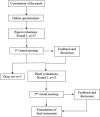Exercise-induced bronchoconstriction in children: Delphi study and consensus document about definition and epidemiology, diagnostic work-up, treatment, and follow-up
- PMID: 39731113
- PMCID: PMC11674617
- DOI: 10.1186/s12931-024-03078-5
Exercise-induced bronchoconstriction in children: Delphi study and consensus document about definition and epidemiology, diagnostic work-up, treatment, and follow-up
Abstract
Background: Exercise-induced bronchoconstriction (EIB) is common in children with asthma but can be present also in children without asthma, especially athletes. Differential diagnosis includes several conditions such as exercise-induced laryngeal obstruction (EILO), cardiac disease, or physical deconditioning. Detailed medical history, clinical examination and specific tests are mandatory to exclude alternative diagnoses. Given the high prevalence of EIB in children and its potential impact on health, sport performance, and daily levels of physical activity, health care professionals should be aware of this condition and able to provide a specific work-up for its identification. The aims of the present study were: (a) to assess the agreement among hospital pediatricians and primary care pediatricians of Emilia-Romagna Region (Italy) about the management of EIB in children and (b) formulate statements in a consensus document to help clinicians in daily clinical practice.
Methods: According to Delphi method, a panel of specialists scored 40 statements that were then revised and discussed during online meetings to reach full consensus. Statements were then formulated.
Results: To obtain full consensus, the questionnaire was administered in two rounds after full discussion of the uncertain topics on the basis of the latest evidence on EIB published over the last 10 years. Despite an overall agreement on EIB management, some gaps emerged in the sections dedicated to diagnosis and treatment. Nine summary statements on definition, pathogenesis, diagnostic work-up, treatment, and follow-up were eventually formulated.
Conclusions: This study describes the knowledge of EIB in a group of pediatricians and highlights gaps and uncertainties in diagnosis and treatment. The creation of statements shared by the specialists of the same area may improve the management of EIB in children. However, more research and evidence are needed to better clarify the best treatment and to standardize the best diagnostic protocol limiting useless examinations but at the same time assuring the best management.
Keywords: Asthma; Athletes; Children; Consensus; Deconditioning; EIB; EILO; Exercise induced asthma; Exercise induced bronchoconstriction; Vocal cord dysfunction.
© 2024. The Author(s).
Conflict of interest statement
Declarations. Ethics approval and consent to participate: Not applicable. Consent for publication: Not applicable. Competing interests: The authors declare no competing interests.
References
-
- Jones RS, Buston MH, Wharton MJ. The effect of exercise on ventilatory function in the child with asthma. Br J Dis Chest. 1962;56:78–86. - PubMed
-
- Weiler JM, Anderson SD, Randolph C, Bonini S, Craig TJ, Pearlman DS, et al. Pathogenesis, prevalence, diagnosis, and management of exercise-induced bronchoconstriction: a practice parameter. Ann Allergy Asthma Immunol. 2010;105:S1-47. - PubMed
-
- Carlsen KH, Anderson SD, Bjermer L, Bonini S, Brusasco V, Canonica W, et al. Exercise-induced asthma, respiratory and allergic disorders in elite athletes: epidemiology, mechanisms and diagnosis: part I of the report from the Joint Task Force of the European Respiratory Society (ERS) and the European Academy of Allergy and Clinical Immunology (EAACI) in cooperation with GA2LEN. Allergy. 2008;63:387–403. - PubMed
-
- Weiler JM, Brannan JD, Randolph CC, Hallstrand TS, Parsons J, Silvers W, et al. Exercise-induced bronchoconstriction update—2016. J Allergy Clin Immunol. 2016;138:1292-1295.e36. - PubMed
-
- Parsons JP, Hallstrand TS, Mastronarde JG, Kaminsky DA, Rundell KW, Hull JH, et al. An official American Thoracic Society clinical practice guideline: exercise-induced bronchoconstriction. Am J Respir Crit Care Med. 2013;187:1016–27. - PubMed
MeSH terms
LinkOut - more resources
Full Text Sources


